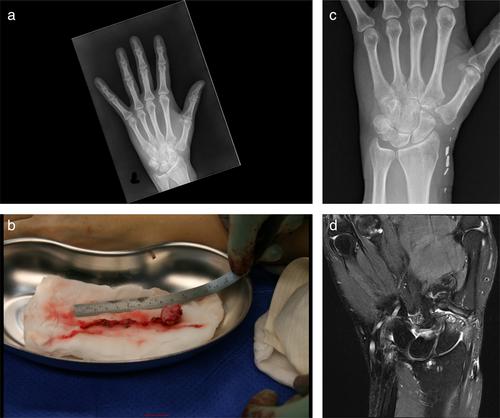Interposition of Free Vascularized Fascia Into the Trapezial Resection Cavity for the Surgical Treatment of Trapeziometacarpal Osteoarthritis
Abstract
Backround
Trapeziometacarpal osteoarthritis has been treated with interposition of autologous fascia into the trapezial resection cavity to prevent scaphometacarpal impingement with suboptimal results. Autologous fascia may undergo necrosis and gradual shrinkage due to avascularity. We propose vascularization of the interposed fascia using microvascular techniques as a new alternative to achieve a durable graft with sufficient soft tissue volume.
Patients and Methods
In this retrospective study, 11 surgeries for 8 patients (6 women, 2 men) (5 primary and 6 revision cases) were performed using vascularized fascial grafts from the anterolateral thigh for interposition in the trapezial resection cavity with microvascular anastomosis for revascularization. Subjective assessment included the short version of the Quick Disabilities of the Hand, Shoulder and Arm and patient related hand wrist evaluation scores. Objective assessment included strength and range of motion measurements. Radiographs were obtained preoperatively and at each follow-up visit. An MRI was done at a mean of 19 months postoperatively.
Results
The size of the harvested fascial grafts was 2 × 2–3 cm with a thickness of 1.5–2 cm. There were no postoperative complications apart from one seroma in the graft harvest site. The mean clinical and radiologic follow-up was 2 years and 8 months. The procedure provided pain relief PRWHE pain 32 (SD 13)—9 (SD 12), p < 0.0001, increased tip pinch strength 4 kg (SD3)—6 kg (SD2), p < 0.05, and improved overall function PRWHE 60 (SD28)—16 (SD21), p < 0.0001 and QuickDash 50 (SD21)—13 (SD17), p < 0.0001. Radiographs demonstrated maintenance of the scaphometacarpal space, while MRI scans showed the presence of mildly edematous interposed tissue within the resection cavity.
Conclusions
Although technically demanding, vascularized fascia presents an attractive alternative for the treatment of trapeziometacarpal osteoarthritis. It may be particularly advantageous in complex cases requiring revision surgery and in young patients with high functional demands.


 求助内容:
求助内容: 应助结果提醒方式:
应助结果提醒方式:


